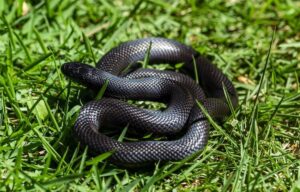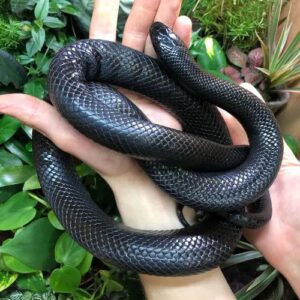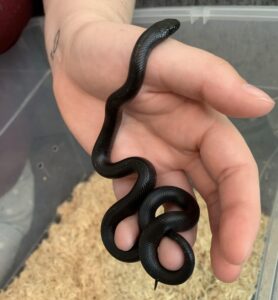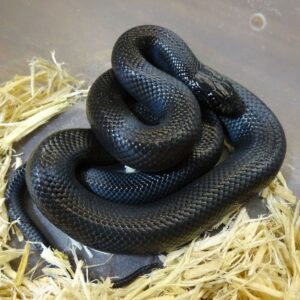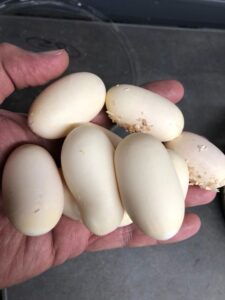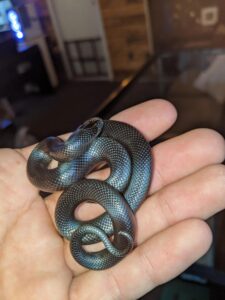Mexican Black Kingsnake (Lampropeltis getula nigrita)
Updated on
25/04/2024The Mexican black kingsnake is a moderately-sized, primarily terrestrial, subspecies of the eastern kingsnake. It tends to be stocky and plump in girth. Their muscular build doesn’t make them rely on their length to overcome prey. They are capable swimmers and climbers. The intensely-colored solitary colubrid interacts only when it needs to mate.
Scientific Classifications
- Suborder:Serpentes
- Family:Colubridae
- Genus:Lampropeltis
- Species:L. getula
- Subspecies:L. g. nigrita
Conservation Status
Description
Size
The average size of a full-grown wild Mexican black kingsnake is 90-120 cm (3-4 ft). But in captivity, some of them can get as big as 5 ft (1.5 m) or even more. It can be attributed to the bigger and more stable diet they receive as pets. The colubrids can weigh up to 3 lbs (1.3 kg), depending on their size.
Color and Appearance
Despite its common name, it is a misconception that the subspecies is black in color. It is actually a deep, dark shade of chocolate – something that can only be seen under direct light. Even its belly is of the same color. The scales are iridescent blue, making the snake look attractive. A full-grown adult has no visible patterns of any kind. But the juveniles can sometimes have small spots of yellow or white, particularly under their chin. However, they disappear or fade completely when they mature.
Are They Dangerous to Humans
Being a constrictor, the kingsnake lacks venom. So its bite is not dangerous. The peaceable snake is usually not aggressive. On being threatened, it hisses, flattens its head, sounds its rattle, makes jerky movements, coils up, and may even strike. An angry snake can musk a foul-smelling combination of oils and feces all over the attacker.
Mexican Black Kingsnakes at a Glance
Distribution
It occurs in the Sonora Desert, northwestern Sinaloa in Mexico, and small parts of Arizona.
Habitat
The subspecies occupies places having lush vegetation and rocky areas in its range.
Lifespan
It lives for as long as 20-30 years.
Predators
The Mexican black kingsnake falls prey to feral cats, coyotes, foxes, owls, and hawks.
Diet
It consumes other snakes (particularly rattlesnakes that share its range), leading it to develop resilience to various types of venoms. It also eats lizards, small rodents, birds, and eggs.
Though the snake is active both during the day and night, it tends to forage in the daytime as it depends on its vision for predation. But as its vision is severely limited in terms of clarity, it is equipped with an acute sense of detecting movements.
Reproductions
Oviparous (lays eggs that hatch outside the body)
Summer sees the females lay clutches of 6-12 eggs. They hatch after 65-80 days. The mother does not care for her young and leaves after laying eggs. The hatchlings measure 8 in (20.32 cm) in length and can forage right from their first meal.
Similar Species
Black Milk Snake
The black milk snake (Lampropeltis triangulum gaigeae) is bigger, with the males typically larger than the females. But for the Mexican black kingsnakes, the males and females are almost the same size.
The California kingsnake (Lampropeltis californiae) is not solid-colored and has alternating dark and light bands on its body.
Care Sheet
Being well-natured, tolerant to handling, and easy to care for, the Mexican black kingsnake makes a good pet. This is also why it is a favorite with beginners.
Size of the Enclosure: It needs to be housed in a 40-gallon glass tank. The babies can be kept in 15-gallon enclosures, while the juveniles need 20-gallon ones.
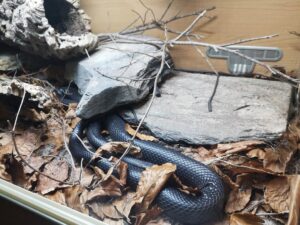
Temperature: The ambient temperature of the cage setup should be maintained at 75°-80°F with the hot end kept at 88°-90°F.
Humidity: The pet needs moderate humidity levels of 40-60%.
Substrate: A sand and soil mixture is ideal as the substrate as it is loose enough to burrow in and can be kept moist to provide humidity in the tank setup.
Feeding: They can be kept on a diet of thawed mice. The feeding frequency should be every 5 days for the hatchlings, 7-10 days for babies above one year of age, and 10-14 days for adults.
Source
everythingreptiles.com, reptilecymru.co.uk, reddit.com, reptilesncritters.com, fbcdn.net, customreptilehabitats.com,

